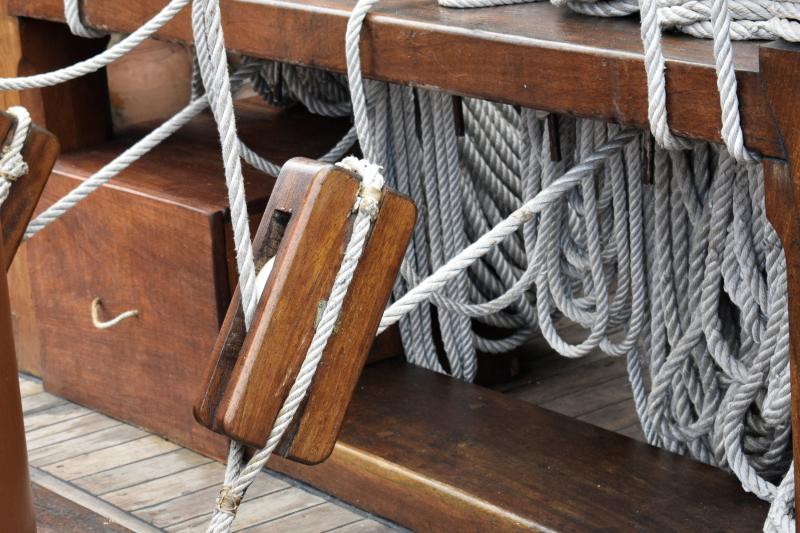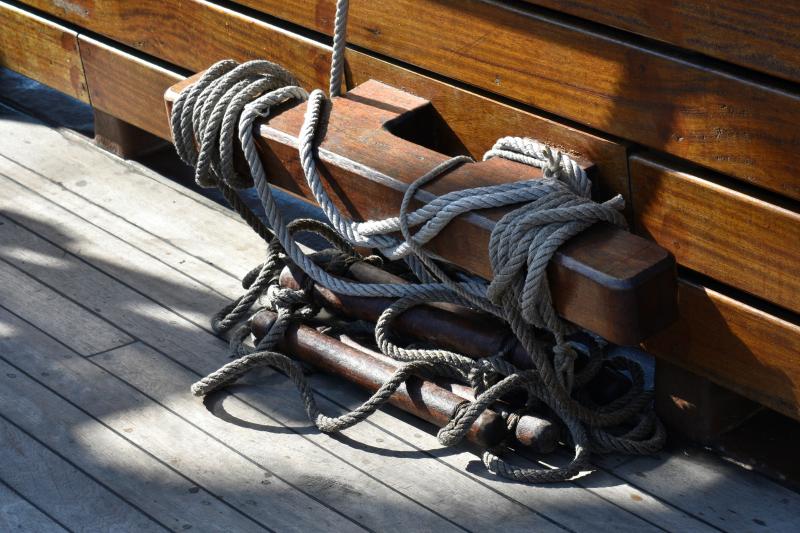Life aboard the Nao Santa Maria
 Edgecomb Eddy School students and other visitors tour the Nao Santa María in Boothbay Harbor. JOSEPH CHARPENTIER/Boothbay Register
Edgecomb Eddy School students and other visitors tour the Nao Santa María in Boothbay Harbor. JOSEPH CHARPENTIER/Boothbay Register
 Visitors board the ship. JOSEPH CHARPENTIER/Boothbay Register
Visitors board the ship. JOSEPH CHARPENTIER/Boothbay Register
 Edgecomb Eddy School students pile onto the deck. JOSEPH CHARPENTIER/Boothbay Register
Edgecomb Eddy School students pile onto the deck. JOSEPH CHARPENTIER/Boothbay Register
 JOSEPH CHARPENTIER/Boothbay Register
JOSEPH CHARPENTIER/Boothbay Register
 JOSEPH CHARPENTIER/Boothbay Register
JOSEPH CHARPENTIER/Boothbay Register
 JOSEPH CHARPENTIER/Boothbay Register
JOSEPH CHARPENTIER/Boothbay Register
 JOSEPH CHARPENTIER/Boothbay Register
JOSEPH CHARPENTIER/Boothbay Register
 JOSEPH CHARPENTIER/Boothbay Register
JOSEPH CHARPENTIER/Boothbay Register
 JOSEPH CHARPENTIER/Boothbay Register
JOSEPH CHARPENTIER/Boothbay Register
 JOSEPH CHARPENTIER/Boothbay Register
JOSEPH CHARPENTIER/Boothbay Register
 JOSEPH CHARPENTIER/Boothbay Register
JOSEPH CHARPENTIER/Boothbay Register
 JOSEPH CHARPENTIER/Boothbay Register
JOSEPH CHARPENTIER/Boothbay Register
 JOSEPH CHARPENTIER/Boothbay Register
JOSEPH CHARPENTIER/Boothbay Register
 JOSEPH CHARPENTIER/Boothbay Register
JOSEPH CHARPENTIER/Boothbay Register
 JOSEPH CHARPENTIER/Boothbay Register
JOSEPH CHARPENTIER/Boothbay Register
 JOSEPH CHARPENTIER/Boothbay Register
JOSEPH CHARPENTIER/Boothbay Register
 JOSEPH CHARPENTIER/Boothbay Register
JOSEPH CHARPENTIER/Boothbay Register
 JOSEPH CHARPENTIER/Boothbay Register
JOSEPH CHARPENTIER/Boothbay Register
 JOSEPH CHARPENTIER/Boothbay Register
JOSEPH CHARPENTIER/Boothbay Register
 JOSEPH CHARPENTIER/Boothbay Register
JOSEPH CHARPENTIER/Boothbay Register
 JOSEPH CHARPENTIER/Boothbay Register
JOSEPH CHARPENTIER/Boothbay Register
 JOSEPH CHARPENTIER/Boothbay Register
JOSEPH CHARPENTIER/Boothbay Register
 JOSEPH CHARPENTIER/Boothbay Register
JOSEPH CHARPENTIER/Boothbay Register
 JOSEPH CHARPENTIER/Boothbay Register
JOSEPH CHARPENTIER/Boothbay Register
 JOSEPH CHARPENTIER/Boothbay Register
JOSEPH CHARPENTIER/Boothbay Register
 JOSEPH CHARPENTIER/Boothbay Register
JOSEPH CHARPENTIER/Boothbay Register
 JOSEPH CHARPENTIER/Boothbay Register
JOSEPH CHARPENTIER/Boothbay Register
 JOSEPH CHARPENTIER/Boothbay Register
JOSEPH CHARPENTIER/Boothbay Register
 JOSEPH CHARPENTIER/Boothbay Register
JOSEPH CHARPENTIER/Boothbay Register
 Edgecomb Eddy School students and other visitors tour the Nao Santa María in Boothbay Harbor. JOSEPH CHARPENTIER/Boothbay Register
Edgecomb Eddy School students and other visitors tour the Nao Santa María in Boothbay Harbor. JOSEPH CHARPENTIER/Boothbay Register
 Visitors board the ship. JOSEPH CHARPENTIER/Boothbay Register
Visitors board the ship. JOSEPH CHARPENTIER/Boothbay Register
 Edgecomb Eddy School students pile onto the deck. JOSEPH CHARPENTIER/Boothbay Register
Edgecomb Eddy School students pile onto the deck. JOSEPH CHARPENTIER/Boothbay Register
 JOSEPH CHARPENTIER/Boothbay Register
JOSEPH CHARPENTIER/Boothbay Register
 JOSEPH CHARPENTIER/Boothbay Register
JOSEPH CHARPENTIER/Boothbay Register
 JOSEPH CHARPENTIER/Boothbay Register
JOSEPH CHARPENTIER/Boothbay Register
 JOSEPH CHARPENTIER/Boothbay Register
JOSEPH CHARPENTIER/Boothbay Register
 JOSEPH CHARPENTIER/Boothbay Register
JOSEPH CHARPENTIER/Boothbay Register
 JOSEPH CHARPENTIER/Boothbay Register
JOSEPH CHARPENTIER/Boothbay Register
 JOSEPH CHARPENTIER/Boothbay Register
JOSEPH CHARPENTIER/Boothbay Register
 JOSEPH CHARPENTIER/Boothbay Register
JOSEPH CHARPENTIER/Boothbay Register
 JOSEPH CHARPENTIER/Boothbay Register
JOSEPH CHARPENTIER/Boothbay Register
 JOSEPH CHARPENTIER/Boothbay Register
JOSEPH CHARPENTIER/Boothbay Register
 JOSEPH CHARPENTIER/Boothbay Register
JOSEPH CHARPENTIER/Boothbay Register
 JOSEPH CHARPENTIER/Boothbay Register
JOSEPH CHARPENTIER/Boothbay Register
 JOSEPH CHARPENTIER/Boothbay Register
JOSEPH CHARPENTIER/Boothbay Register
 JOSEPH CHARPENTIER/Boothbay Register
JOSEPH CHARPENTIER/Boothbay Register
 JOSEPH CHARPENTIER/Boothbay Register
JOSEPH CHARPENTIER/Boothbay Register
 JOSEPH CHARPENTIER/Boothbay Register
JOSEPH CHARPENTIER/Boothbay Register
 JOSEPH CHARPENTIER/Boothbay Register
JOSEPH CHARPENTIER/Boothbay Register
 JOSEPH CHARPENTIER/Boothbay Register
JOSEPH CHARPENTIER/Boothbay Register
 JOSEPH CHARPENTIER/Boothbay Register
JOSEPH CHARPENTIER/Boothbay Register
 JOSEPH CHARPENTIER/Boothbay Register
JOSEPH CHARPENTIER/Boothbay Register
 JOSEPH CHARPENTIER/Boothbay Register
JOSEPH CHARPENTIER/Boothbay Register
 JOSEPH CHARPENTIER/Boothbay Register
JOSEPH CHARPENTIER/Boothbay Register
 JOSEPH CHARPENTIER/Boothbay Register
JOSEPH CHARPENTIER/Boothbay Register
 JOSEPH CHARPENTIER/Boothbay Register
JOSEPH CHARPENTIER/Boothbay Register
 JOSEPH CHARPENTIER/Boothbay Register
JOSEPH CHARPENTIER/Boothbay Register
 JOSEPH CHARPENTIER/Boothbay Register
JOSEPH CHARPENTIER/Boothbay Register
Boothbay Harbor is one of few ports the Nao Santa María has graced since its voyage in the Great Lakes. When the replica ship landed at Pier 1 the afternoon of Sept. 24, dozens of locals and visitors to the region greeted it.
Nao Santa María project manager Ángel Rosa has been sailing with the ship since May 2018. Rosa said the Great Lakes were a wonderful experience, especially sailing with many tall ships, but he and the crew are happy to be back on the ocean.
“Usually, we don't do long navigations,” said Rosa. “The biggest one was across the ocean, the Atlantic. We were like six days from Spain to the Canaries, and then from there to Puerto Rico it was 23 days, (so) 29 in total ... That was amazing, the feeling of being in the middle of the ocean. Crossing the Atlantic in this replica was very meaningful, full of history. It was very, very special.”
Nao Santa María is only one of a few replica ships commissioned by the Huelva-based Fundacion Nao Victoria, an organization whose goal is to share the history of some of the most important 15th and 16th century Nao vessels and their navigation, said Rosa. Another Nao Victoria is being built for the 500th anniversary of Ferdinand Magellan's circumnavigation of the globe.
“Five naos left Seville in August 1519, but only one (survived) – the Nao Victoria. (Magellan) got killed in the Philippines, so he wasn't able to complete the course … and only 20 men came back out of 250.”
The upcoming Nao Victoria will be docked for three years – the length of the circumnavigation – in Seville, Spain next to the Fundacion's center, said Rosa.
The construction of the ship is part “old way” and new technologies, said Rosa. The ship is made from wood, but also has fiberglass construction for safety on the high seas and to prevent copious amounts of round the clock maintenance. The first Nao Victoria replica was constructed mostly as it would have been in the 15th and 16th centuries, and the consequences were, predictably, the same the original construction would have had: constant problems and maintenance, Rosa said.
“So this is perfect for me,” he laughed. “Some people will say, 'Oh, but you have power.' And I'm like 'What do you expect? We don't live in the 15th century.'”
Rosa said it is hard to pick just one favorite part of working and voyaging on the Nao Santa María. He said he and the crew are humbled to be part of spreading the history of ships, maritime voyages and culture.
“(I like) a little of everything. Being part of this historic ship, traveling, being to different parts of the world, showing this ship and meeting a lot of people interested in this history, sailing around in this replica is no common thing. So, I feel very lucky.”
Event Date
Address
United States














































































